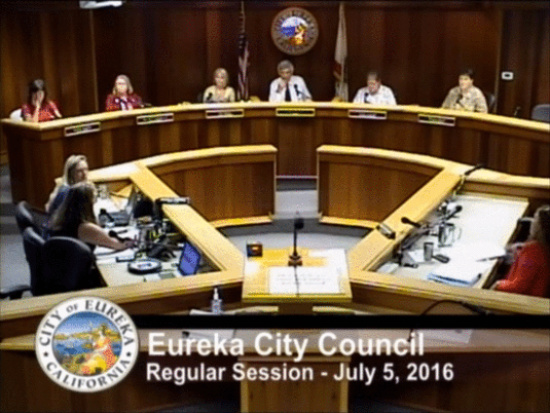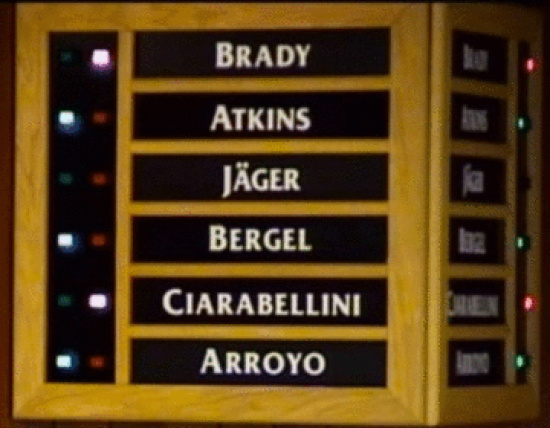Screenshot of last night’s meeting.
Tempers flared and accusations flew last night as the Eureka City Council voted 3-2 to place a voting reform measure on the November general election ballot. The measure will ask voters if the city should change the way council members get elected. Currently the city employs an unusual method whereby one council member is elected from each of the city’s five wards, and yet voters across the entire city get to vote in every city council election. The ballot measure, ostensibly prompted by legal vulnerability, asks residents if they’d like to change to a “true ward system” whereby each council member would be elected only by the residents living in his or her ward. (See Tuesday’s editorial for more on this.)
While city council seats are technically nonpartisan, this particular issue divided both the public and the council along familiar ideological lines. During public comment, proud Democrats Pam and Bob Service got up to speak in favor of the measure, saying that a true ward system would give more voice to minority residents and make the process of running for city council more accessible, which could entice more candidates to seek office.
But more conservative residents, including past council candidate Joe Bonino and rumored future candidate John Fullerton, spoke against the measure. Bonino said it would “balkanize” the city. “You’d wind up with five people, each only concerned about their own district,” he said.
The council’s own discussion of the matter started off calmly enough. Ward 2 Councilmember Linda Atkins said the “elephant in the room” was the fact that only district elections, of the kind being proposed in the measure, pass legal muster under the California Voting Rights Act. With various California cities being sued over their at-large voting systems, which critics say disenfranchise minorities, Eureka is legally vulnerable, she said.
“So I would like to allow the citizens of Eureka to decide if they want to spend millions of dollars to try to support our old, antiquated system, or if they just want to go on … [and switch] to district elections,” Atkins said.
Ward 3 Councilmember Kim Bergel agreed that it should be put to the voters, as did Ward 5 Councilmember Natalie Arroyo, who noted that with only her own ward to canvas she would have time to reach out to people not currently involved in the political process, including the Latino and Hmong residents in her ward.
These three — generally considered the lefty wing of the council — were united. But Ward 1 Councilmember Marian Brady had a different view, and her comments led to a passionate response from Atkins. She said Brady’s condescending tone really pissed her off, and she accused her fellow councilmember of not paying attention.
Watch:
Afterwards, Ward 4 Councilmember Melinda Ciarabellini said that, like Brady, she’s opposed to putting this on the ballot. She said she’s not convinced that the city would necessarily be sued over its current voting system, and she argued that more research is needed to determine whether Eureka is racially polarized.
Before giving the floor back to Brady, Mayor Frank Jager pleaded, “Let’s try not to get personal, please.” Brady didn’t get personal, but her rhetoric certainly escalated. Picking up on Ciarabellini’s comments she asked her fellow councilmembers how they could possibly vote on the issue without more information.
“This is unconscionable,” she declared. “It just is wrong — on so many levels.”
She also criticized the timing of the measure, which needed to pass last night in order to legally qualify for the November election. “This is coercion at its worst,” Brady said.
Everyone else on the dais appeared a bit embarrassed by the inflamed passions. “I think asserting that this is coercion is a pretty intense accusation,” Arroyo said. She noted that the city council has been talking publicly about amending the charter for at least a year and a half and said there’s plenty of time to give voters more information before the November election. And with that she moved to place the amendment on the ballot, and the vote went like this:
Green means yes; red means no.


CLICK TO MANAGE